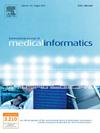用于预测ICU缺血性脑卒中患者住院死亡率的可解释机器学习模型的开发和验证
IF 3.7
2区 医学
Q2 COMPUTER SCIENCE, INFORMATION SYSTEMS
International Journal of Medical Informatics
Pub Date : 2025-03-09
DOI:10.1016/j.ijmedinf.2025.105874
引用次数: 0
摘要
背景及时准确的预后预测对于重症监护病房(ICU)缺血性脑卒中患者的临床决策至关重要。然而,预测模型在临床应用中的解释和翻译同样至关重要。本研究旨在开发一种可解释的机器学习(IML)模型,有效预测缺血性脑卒中患者的住院死亡率。方法本研究建立了一个IML模型,并采用3225例ICU缺血性脑卒中患者的多中心队列进行验证。利用上海长海医院的MIMIC-IV和外部验证数据,建立了包括逻辑回归(LR)、k近邻(KNN)、朴素贝叶斯(NB)、决策树(DT)、支持向量机(SVM)、随机森林(RF)、XGBoost、LightGBM和人工神经网络(ANN)在内的9个机器学习(ML)模型来预测住院死亡率。采用三种算法进行特征选择。采用受试者操作特征(AUROC)下面积、准确性、敏感性、特异性和F1评分评价模型的性能。采用校正曲线和Brier评分评价模型的校正程度,生成决策曲线分析评价净临床效益。此外,采用SHapley加性解释(SHAP)方法评价ICU住院缺血性脑卒中患者的院内死亡风险。结果机械通气、年龄、他汀类药物、白细胞、血尿素氮、血细胞比容、华法林、碳酸氢盐和收缩压是9个影响因素。RF模型的预测性能最稳健,在测试集和外部验证集的AUROC值分别为0.908和0.858。校准曲线也显示了观测和预测之间的高度一致性。决策曲线分析表明,当预测概率阈值为0.10 ~ 0.80时,该模型具有最大的净效益。采用SHAP对RF模型进行解释。此外,我们还开发了一个缺血性中风患者的在线预测计算器。结论本研究开发了一种基于机器学习的计算器来预测ICU缺血性脑卒中患者的住院死亡率。该计算器具有指导临床决策的潜力,并通过识别住院死亡风险较高的患者来改善缺血性中风患者的护理。本文章由计算机程序翻译,如有差异,请以英文原文为准。
Development and validation of an interpretable machine learning model for predicting in-hospital mortality for ischemic stroke patients in ICU
Background
Timely and accurate outcome prediction is essential for clinical decision-making for ischemic stroke patients in the intensive care unit (ICU). However, the interpretation and translation of predictive models into clinical applications are equally crucial. This study aims to develop an interpretable machine learning (IML) model that effectively predicts in-hospital mortality for ischemic stroke patients.
Methods
In this study, an IML model was developed and validated using multicenter cohorts of 3225 ischemic stroke patients admitted to the ICU. Nine machine learning (ML) models, including logistic regression (LR), K-nearest neighbors (KNN), naive Bayes (NB), decision tree (DT), support vector machine (SVM), random forest (RF), XGBoost, LightGBM, and artificial neural network (ANN), were developed to predict in-hospital mortality using data from the MIMIC-IV and externally validated in Shanghai Changhai Hospital. Feature selection was conducted using three algorithms. Model’s performance was assessed using area under the receiver operating characteristic (AUROC), accuracy, sensitivity, specificity and F1 score. Calibration curve and Brier score were used to evaluate the degree of calibration of the model, and decision curve analysis were generated to assess the net clinical benefit. Additionally, the SHapley Additive exPlanations (SHAP) method was employed to evaluate the risk of in-hospital mortality among ischemic stroke patients admitted to the ICU.
Results
Mechanical ventilation, age, statins, white blood cell, blood urea nitrogen, hematocrit, warfarin, bicarbonate and systolic blood pressure were selected as the nine most influential variables. The RF model demonstrated the most robust predictive performance, achieving AUROC values of 0.908 and 0.858 in the testing set and external validation set, respectively. Calibration curves also revealed a high consistency between observations and predictions. Decision curve analysis showed that the model had the greatest net benefit rate when the prediction probability threshold is 0.10 ∼ 0.80. SHAP was employed to interpret the RF model. In addition, we have developed an online prediction calculator for ischemic stroke patients.
Conclusion
This study develops a machine learning–based calculator to predict the probability of in-hospital mortality among patients with ischemic stroke in ICU. The calculator has the potential to guide clinical decision-making and improve the care of patients with ischemic stroke by identifying patients at a higher risk of in-hospital mortality.
求助全文
通过发布文献求助,成功后即可免费获取论文全文。
去求助
来源期刊

International Journal of Medical Informatics
医学-计算机:信息系统
CiteScore
8.90
自引率
4.10%
发文量
217
审稿时长
42 days
期刊介绍:
International Journal of Medical Informatics provides an international medium for dissemination of original results and interpretative reviews concerning the field of medical informatics. The Journal emphasizes the evaluation of systems in healthcare settings.
The scope of journal covers:
Information systems, including national or international registration systems, hospital information systems, departmental and/or physician''s office systems, document handling systems, electronic medical record systems, standardization, systems integration etc.;
Computer-aided medical decision support systems using heuristic, algorithmic and/or statistical methods as exemplified in decision theory, protocol development, artificial intelligence, etc.
Educational computer based programs pertaining to medical informatics or medicine in general;
Organizational, economic, social, clinical impact, ethical and cost-benefit aspects of IT applications in health care.
 求助内容:
求助内容: 应助结果提醒方式:
应助结果提醒方式:


